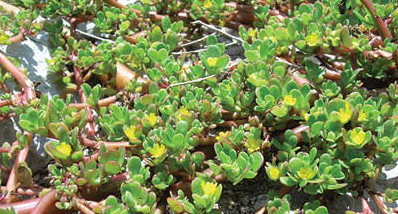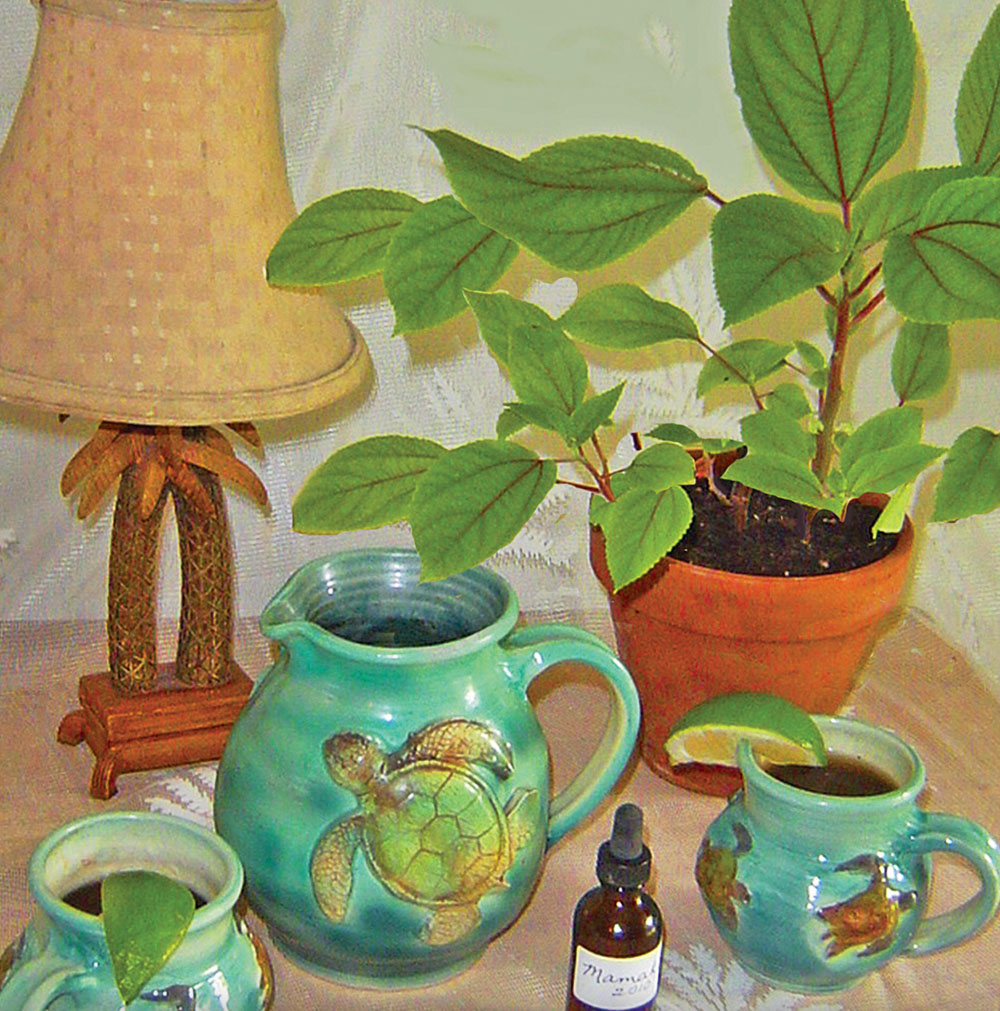
Healing Plants: ‘Ākulikuli Kula, Way More than a Lowly Weed
 By Barbara Fahs
By Barbara Fahs
‘Ākulikuli kula is a fun word to say, and the plant bearing this name has as much to offer in the kitchen as it does in the medicine cabinet.
Also known as purslane and often considered a weed, this low-growing succulent plant belongs to the Portulaca family. Its origin is in question, with some botanists believing the first Portulaca evolved in India or Iran. You might have grown other members of this family as colorful ornamentals in your garden. The “Moss Rose” variety is readily available as a bedding plant at nurseries in most climate zones. The Portulacas are tolerant of hot, dry weather, sporting succulent leaves, and some varieties have one-inch flowers reminiscent of cactus blossoms.
Hawai‘i’s most common Portulaca, the ‘ākulikuli kula, is known in the botanical world as Portulaca oleracea. It thrives in warm, relatively dry environments on all islands except Kaho‘olawe, from sea level to about 3000 feet. Unlike its cultivated cousins, it bears only tiny yellow flowers.
Four species of Portulaca exist in Hawai‘i, such as the endemic Portulaca villosa and Portulaca lutea, native to all of the main islands. An endangered species, Portulaca molokiniensis, hails from Maui and Kaho‘olawe. The introduced Portulaca pilosa originated in Asia and tropical America—it is classified as an invasive species in Hawai‘i.
How to grow ‘Ākulikuli kula
‘Ākulikuli kula makes an attractive and soft groundcover plant. If your property does not already have this common plant, dig up a clump from a friend’s yard and transplant it to a spot that gets plenty of sun. Soil quality is not important; it will even grow on bare lava rock when it spreads on its own.
‘Ākulikuli kula is resistant to most insects and plant diseases. However, it can provide cover for the giant African snail and other garden pests, so watch for the existence of these creatures.
It is not considered invasive, although it can spread widely in your garden. If this happens, it’s a good opportunity to pull some up, wash it thoroughly, and add it to a salad.
Culinary and Nutritional Uses
Purslane has long served as an ingredient in such countries as Crete and Uzbekistan. Martha Washington used it pickled in a recipe calling for sweetmeats. It failed to attract a large fan base until recently. Today, purslane is available for sale at gourmet farmer’s markets and is used at elegant restaurants.
Like certain fish, such as salmon, ‘ākulikuli kula is rich in Omega-3 fatty acids, which are known as important nutrients for the heart. It also contains beta-carotene, a fat-soluble compound that converts to vitamin A.
Add ‘ākulikuli kula raw to salads for a lemony peppery flavored zing that also adds a bit of crunch similar to a cucumber. Added to soups, it lends a taste similar to arugula. One recipe calls for purslane along with avocados for an unusual taco. Stewed with pork in a tomatillo sauce, purslane makes for a delicious Mexican-style dish.
Medicinal Uses
The antioxidants and Omega-3 oil contained in all of the Portulacas make the plant especially healthful. According to Michael Tierra in his popular book, The Way of Herbs, plants that provide antioxidants can be helpful in combating cancer.
Portulaca oleracea has antibacterial properties, according to a paper published in Pacific Science in 1950. The authors believe this plant was used in ancient times for general debility. They also state that the plants in their study, including Portulaca oleracea, were used as “cathartics, vermifuges, emollients, astringents, analgesics, and counterirritants… as well as for their action in preventing infection and for treating an infection once it had begun.”
In modern times, purslane can be used to boost insulin levels and the immune system, relieve asthma, treat psoriasis, reduce heart arrhythmia, prevent headaches, and as an antidote to excessive caffeine consumption. You can get your daily dose of purslane by brewing it into tea, blending it with olive oil for a tangy pesto sauce, stir-frying it, or pickling it.
No known contraindications or adverse effects for the consumption of Portulaca oleracea exist. If you are pregnant or nursing, talk to your health care provider before taking it or any herb or drug. ❖
Photo courtesy Forest and Kim Starr
Contact writer Barbara Fahs
References/Sources:
• ChicagoTribune.com/dining/recipes/sns-food-recipes-sides-purslane-story.html
• Drugs.com/npp/purslane.html
• Gardening.cornell.edu/homegardening/scene3552.html
• GardenGuides.com/67691-grow-purslane.html
• Hear.org/pier/species/portulaca_pilosa.htm
• HiHort.blogspot.com/2012/08/weed-or-food-ubiquitous-purslane.html
• MexConnect.com/articles/2211-juana-perez-pork-with-greens-puerco-con-verdolagas-de-juana-perez
• NativePlants.hawaii.edu/plant/view/Portulaca_villosa
• NativePlants.hawaii.edu/plant/view/Portulaca_molokiniensis#environmentalinformation
• OrganicAuthority.com/eco-chic-table/dont-pull-the-purslane.html
The Antibacterial Properties of Some Plants Found in Hawaii. A. Bushnell, Mitsuno Fukuda, and Takashi Makinodan. Pacific Science, volume IV, July 1950. (ScholarSpace.manoa.hawaii.edu/bitstream/handle/10125/9005/vol4n3-167-183.pdf)


